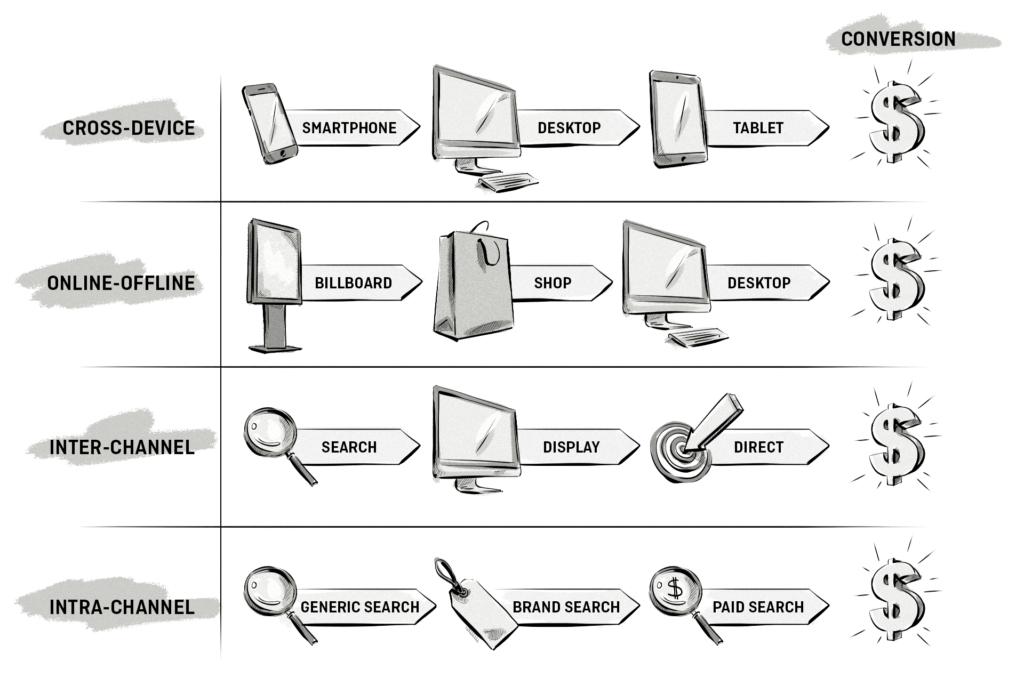One of the most recent and primary challenges in the online marketing world can be described with a single word – attribution.
Online marketing and web analytics have become so complex since the concept of attribution was introduced that not only is this a huge challenge for marketers who have to update their skills and knowledge, but also for the Ad Tech industry ajs it now needs to provide proper technology that can deal with multi-channel attribution.
So what is it about attribution that is giving marketers such a headache?
In general, attribution in the marketing world covers 3 main areas – multi-channel attribution, conversion attribution, and multi-touch attribution.
And all of the mentioned areas beg the following questions:
- If someone became our customer, what were his/her touchpoints with our brand during their customer journey?
- When a customer converts (e.g. buys a product or downloads an ebook), how much credit should be attributed to the different channels and touch points they interacted with?
- Which channels contributed the most? Was it the mobile ad on Facebook? The TV Ad? The email campaign? Or was it maybe the conversation our customer had with our salesperson in our brick and mortar store?
- How do the different channels overlap and influence the conversion as a combined group?
Answering these questions is exactly what attribution is all about.
The Problem With Attribution
The main issue with traditional attribution models is this –
Traditional attribution models focus on single channels, but consumers use multiple channels and devices.

Therefore, it’s very difficult to properly attribute conversions when consumers are exposed to ads and marketing material on more than one channel (e.g. social, search, display, email, etc.) and when they use more than one device (e.g. laptop, tablet, and smartphone).
But the reality is that proper, accurate attribution runs deeper than just cross-device and cross-channel, and there are many different types of attribution that focus on different areas.
Right now we can name 4 main types of attribution for which the Ad Tech & MarTech industry is trying to find reliable solutions to demystify the big picture behind attribution.
The 4 Different Types Of Attribution

Cross-Device Attribution
Attribution has never really been easy for marketers, and the introduction and rise of multi-device usage has just made things harder.

Just when marketers started making progress with online-offline attribution, cross-device attribution started knocking at the door.
Cross-device attribution aims to measure and attribute the various touch points a customer had with a brand before they converted across different devices (e.g. a laptop, tablet, and smartphone).
The sad part is that achieving this kind of attribution is no easy feat, especially when 40% of online adults start an activity on one device and then complete it on another.
And while there are methods like deterministic and probabilistic matching that can identify one user across different devices with anywhere from 70% – 90% accuracy, they both come with their challenges and shortfalls.
As more and more consumers adopt a multi-device habit, there’s no doubt that cross-device attribution will remain the main focus for marketers, Ad Tech, MarTech, and analytics companies in the coming years.
Online to Offline and Offline to Online Attribution
This is perhaps the oldest of all the attribution issues and it started when brick and mortar stores and companies started making their way to the online world.

In particular, advertisers and marketers want to find the answer to the following:
- How many online sales and conversion can be attributed to the outdoor ads (e.g. billboards and leaflets)?
- How many online sales and conversion can be attributed to TV or radio ads?
- How many online sales and conversions can be attributed to sales people speaking with potential customers in the brick and mortar stores?
These questions are not easy to answer, but are extremely important for companies that rely on offline and online channels.
Currently, there isn’t a single technological solution or tool that allows marketers to accurately measure offline to online attribution. Instead there are several workarounds and old-school methods available.
Online-Offline Attribution Techniques
1. Using redirects and vanity URLs These are special, unique URLs used solely for the purpose of driving traffic from one medium (e.g. a TV ad) to a website. They are usually linked with a marketing campaign.
2. Time-limited attribution windows: This technique uses a set time frame to attribute website visits to a marketing campaign – e.g. if you run a TV ad at 7pm, then all visits from 7pm-8pm will be attributed to the TV ad campaign.
3. Online and point of sale (POS) surveys: This old-school technique involves asking customer how they found out about your company – whether that be online during a purchase process or at POS in a store. It’s very simple to implement and is often quite effective. The only issue is that not everyone fills in online surveys.
4. Using unique redeemable coupons/offer codes: The use of coupons and offers has been around for decades as a way to attract more customers, but they can also be used to attribute online-offline (and vice versa) sales. For example, if a customer receives a discount coupon via email and then uses that coupon in a brick and mortar store, then the company can accurately attribute it to the online email campaign.
5. Postal Codes: Knowing a customer’s post code (collected during the checkout/shipping stage when finalizing an ecommerce transaction) allows marketers to measure the distribution of their offline campaigns (e.g. direct mail, leaflets, billboards) and target customers with online display ads based on their location.
6. Beacons: The beacon attribution technique is one of the newest techniques out there. By utilizing the power of Bluetooth, marketers can attribute online marketing campaigns with offline purchases. They are able to achieve this by identifying a customer’s smartphone (usually via the company’s app that the user has downloaded) using an in-store beacon.
To read about the above online-offline attribution techniques in more detail, click here.
Inter-Channel Attribution

Back in the old days (which was just a few years ago) each online conversion was attributed to the last known referral or traffic source and life was smooth and easy. But it wasn’t long until online marketers discovered that this was just a very simplistic and misleading model.
Intra-Channel Attribution
Intra-channel attribution focuses on attributing conversions within the same channel – e.g. search.

This model is useful if you want to discover how different areas of the same channel contribute to conversions.
For example, you could look at how paid search and organic search influence conversions and subsequently assign more effort and marketing dollars to the one that is producing the best results.
Google AdWords was the first company to offer intra-channel attribution. Advertisers and marketers using AdWords can view reports that show how different AdWords campaigns influence each other in the lead up to a conversion.
While the inter- and intra-channel attribution models provide isolated insights into particular channels, they fail to capture the complexity of the online customer journey and do not take into account the fact that a single customer can be influenced by several marketing channels (e.g. Facebook, AdWords, SEO, email etc.) at the same time.
It’s for this reason alone that the concept of multi-touch attribution models was born.
Multi-touch (or multi-interaction) attribution models were created to help measure and attribute conversions to the individual touchpoints, online channels, and even individual ad clicks.
Nowadays, most web analytics and marketing tools still use the old-fashioned last click attribution model as the default conversion reporting model, but more and more are starting to offer different, more up-to-date attribution models for the enlightened and modern marketers.








